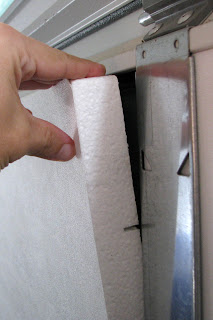 |
| Garage Door Insulation Kit |
Many garage doors these days are un-insulated and light weight metal that simply transfer heat and cold. In the Arizona low desert, cold weather is only a concern for about 2 months, and hardly that if you live in an urban area. But even here, garage door insulation often makes sense. In the summer the surface temperature of the garage door can reach 140 degrees! That heat radiates into the garage, and if you have living space over the garage, it radiates straight up into your living area.
Luckily, it is very easy to retrofit insulation onto a garage door. Fiberglass and polystyrene garage insulation kits can achieve R5 to R8 insulation values, providing not only excellent thermal protection, but also some noise reduction. As simple as this project is, there are (as always) a few options and considerations to take into account.
The first decision is whether garage insulation makes sense for you, or not. For me, it makes sense because I have living space over top of my garage, and it is exposed to the south in our oppressive heat. For much of the day the sun is shining directly onto the garage. It would also make sense in my childhood home, because of the cold climate and living space on top of the garage.
However, here in Arizona it may not be the best choice for an eastern exposure garage, for example. Your mileage may vary depending on shading and amount of living space over the garage
Also be aware that not only will the insulation keep heat and cold out, but it will also keep heat in. Consider how hot a car gets, and pulling it into a small enclosed space like a garage results in a lot of heat, and the insulation will only keep it in longer. Minor behavioral changes can mitigate this concern, such as leaving the car in the driveway when you get home from work, and pulling it into the garage before bedtime; or simply vent the garage for a few hours.
The next choice is whether you want to buy a kit, or simply buy sheets of polystyrene insulation. Kits offer some convenience, though you still end up having to cut the insulation. Sheets are definitely cheaper but bulkier to transport and may not fit in small or even some midsize cars.
Kits come in two main forms from Home Depot or Lowes - an Owens Corning 3" fiberglass kit
I personally ended up using the Insulfoam kit as I couldn't transport the larger sheets in my small car. The kits only fit 8 panels, so you'll need two for a double garage door.
 |
| Insulfoam Installation |
The polystyrene is a little messy when cut, and you will end up with little balls of polystyrene that need to be vacuumed up.
And if you decide to get sheets of insulation, be sure to measure the thickness of your doors - 1.25 seems pretty standard but they can vary. The big box stores offer a wide variety of insulation types and thickness, so it helps to be prepared.
And to wrap things up, you may want to consider installing vinyl garage door seals to create a nice seal.

Well done site! But my project list is growing too long because of it!
ReplyDeleteGarage door replacement and garage door sectional replacement needs certain skills
ReplyDeleteand safety techniques to correctly install these parts. Some garage door parts such as
springs are never allowed to be fixed by an untrained person because of the extreme
tension it stores which will cause injury or even death. Car insulation